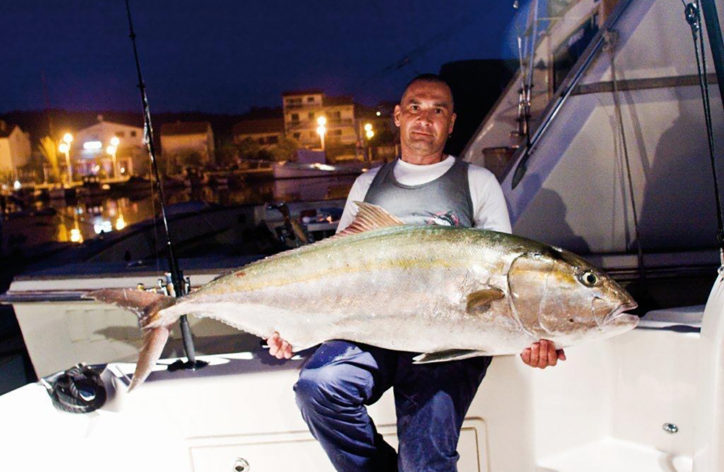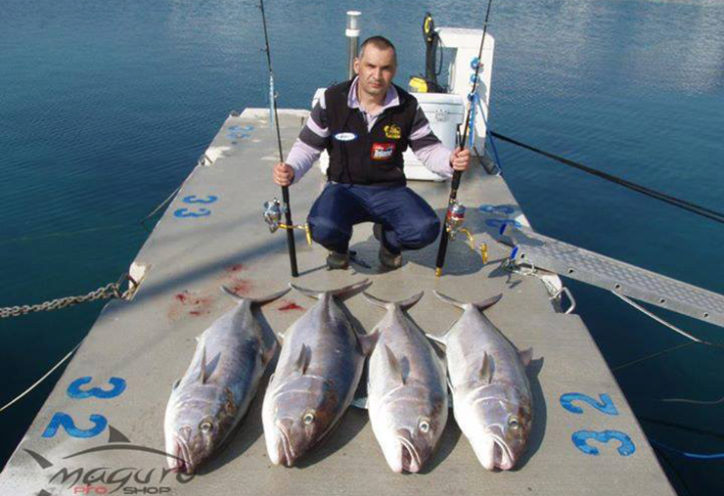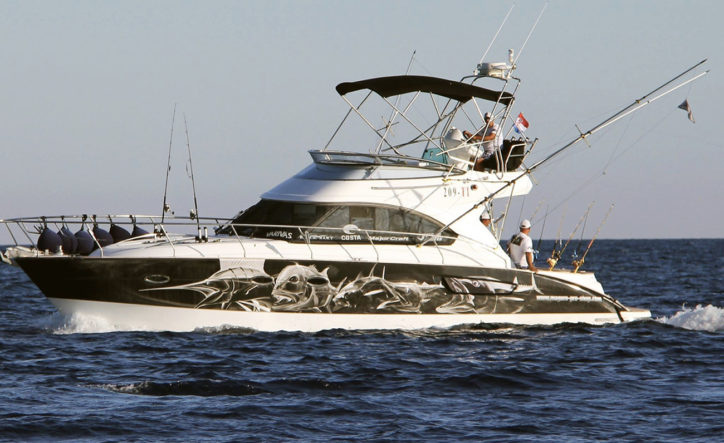adriaticnature does its best and tries hard to talk to the maximum number of well-known fishermen and interesting people who go crazy over the Sea, rivers, and lakes of nearby banks, and who have something to share with readers.
Sasha Rakar is one of the most prominent fishermen of the Adriatic, a good friend and like-minded fellow of adriaticnature, an innovator and experimenter who has traveled half the world in search of trophies and found them in the Adriatic Sea. Concurrently, Sasha is the owner of one of the largest fishing stores in Europe – Maguro, based in Zagreb, Croatia. adriaticnature decided to talk to him about the way Sasha became one of the icons of fishing not only on the Balkan Peninsula.

(Sasha Rakar with a greater amberjack. Photo by © Saša Rakar)
Hello Sasha! Thanks for getting round to having this conversation. I hope we’ll have regular communication on the pages of adriaticnature in the future. So, let’s start with a story about you. How did you start your fishing career and what is happening to you nowadays?
My first acquaintance with fishing took place on rivers and lakes, since I was born and spent my childhood far enough from the sea coast in Zagreb.
However, the love of the sea has always attracted me to it. As I was growing up, I began to go sea fishing more and more often. Often it happened in winter and, at some point, I decided to purchase a boat, which would also be located in the place where I could store it in comfortable conditions in winter. I ended up in the town of Jezera on the island of Murter, which is located between the coastal Croatian cities of Zadar and Sibenik, and which is the center of tuna fishing on the northern Adriatic coast.

(Jezera – a town and a port on the north-east side of the island of Murter. Photo © croatia.hr)
In Jezera, I met fishermen who were crazy over tuna fishing. I turned on the heat and decided to try to start catching these magnificent fish, especially since the boat was perfect for this fishing. Soon I caught a tuna weighing 98 kg for the first time. That’s how I finally got into the sea fishing and have stayed in Jezera to this day. 13 years have passed since I came to that place for the first time.
At that time, we caught tuna and swordfish across the Adriatic, took part in competitions, with the help of which I mastered and learned a lot. Ultimately, this led me to the “Big Game” team in Croatia. And I became a coach of this team due to my experience in pelagic fish trolling.
As luck would have it, I gained this experience on numerous fishing trips, fishing for sailfish and marlin. By the way, after that catching swordfish has always attracted me more than catching tuna.

(Sasha Rakar with a swordfish. Photo by © Saša Rakar)
At some point, I realized that I had a pretty good understanding of the issue, practicing fishing, following events and news, and decided to become the captain of IGFA (International Game Fishing Association). I completed training, passed the exam, and then my future colleagues from IGFA suggested that I represented the interests of IGFA in Croatia. I accepted the offer with pleasure and since then I have been their representative.
Fishing, like any sport, is developing rapidly. I didn’t forget about this while fishing for tuna, and regularly trolling in different parts of the world.
Following the fishing novelties, buying all sorts of innovations in stores around the world, I noticed the growing popularity of fishing with the add-on “jigging”. Vertical jigging. It was absolutely new for me, I have never dealt with this type of fishing and I haven’t even tried it. There was no one in my fishing company who even had minimal experience, not to mention gear. Jigging was a challenge for me. But I knew where the fish was near the bottom.
At that time I was writing articles for the popular magazine “Ribolov na Jadranu” (“Fishing on the Adriatic Sea”), the articles that, in my opinion, were informative and interesting, as I tried to share details about catching tuna, day and night swordfish catching, backed by their own results. And what about jigging?! My texts began to drag behind – it’s impossible to write about the same thing, but I had nothing to write about vertical jigging. It would be foolish to talk about the stuff, if you have no idea about it.

(Sasha Rakar with a grouper. Photo by © Saša Rakar)
I have always wondered how one could sit down and write a book or an article in any periodical about the stuff they know nothing about (which, unfortunately, happens every now and then). Writing about any innovative methods of fishing without leaving the apartment and going to the water body has unfortunately become a tradition, mildly speaking, an unpleasant tradition. Fishermen, who strive for real knowledge, while trusting 90% of the information posted by the authors, read pointless texts, paid for by sponsors. And then they buy the gear, 90% of which will have no effect or will be unreliable.
But let’s get back to the sea realities. If you want to get acquainted with the trophy fish on the sea – it will require high-quality gear. They are not cheap. However, in my humble opinion, the most expensive and unreasonable investment is the loss of trophy fish when using low-quality equipment.

(Sasha Rakar with greater amberjack. Photo by © Saša Rakar)
I bought two sets of gear for vertical jigging and planned to keep studying them for two full days, at first. My companion and the most frequent fishing partner Vladimir Pezo, a well-known fisherman, who catches tuna well, and I went fishing to try and make sure of the efficiency of this fishing method.
On the first day, we gave up quickly and switched to fishing with leger rigs from a boat using baits of natural origin. The result left much to be desired, and when we get down to business, we made ourselves “deal” with jigging the next day.
In the morning of the second day of the planned schedule, we didn’t really understand jigging to the core but reached positions that were known for catching dentexes and amberjacks. There were already two boats, from which the fishermen tried to catch something in vain, using live squid as bait. I still remember that day, as if it happened yesterday. And I remember the first glances that the guys from the neighboring boats were throwing at us when we lowered jigs into the water and began to make those movements with spinning rods, which should be made with vertical jigging. Surely it looked very funny from the outside, and even we laughed at ourselves deep inside. I was “jigging” from the stern of my Beneteau Antares 12, and Vladimir was jigging from the nose.

(Readiness for action. Photo by © Saša Rakar)
The echo sounder specified that there was a large and dense school of small fish at a depth of 70 meters. I lowered the jig to the bottom, remembered at one point all the articles and literature I read on this issue (by the way, at that time I was greatly impressed by the book “Rudow’s guide to modern jigging: inshore, offshore, species-specific”) and began lifting it with movements, as I imagined them according to the printed word. And, at the moment when the jig flew up to the side of the boat (I thought it was 15 meters from the bottom), there was a severe bite I hoped for, but still, I wasn’t ready for it. I didn’t have time to strike the fish, it escaped.
Never getting a chance to swear, I heard Vladimir’s loud cries from the nose of the boat. I rushed to help him and saw that the spinning rod in his hands was bent almost like an arc. It was bent up to the handle, as far as it would go. I’ll say it again, Vladimir is an excellent fisherman, and no matter how difficult playing the fish with an unfamiliar gear is, it was impossible to puzzle him. Due to this, we soon admired the amberjack, weighing about 30 kilograms, lying on the deck of the ship.
That was the moment when jigging was born in Croatia. Vladimir turned out to be the pioneer of this beautiful fishing trend, catching the first large fish in the country using the jig.
The catch didn’t finally make fishermen believe in the new fishing technique. About one and a half weeks passed after we caught the first amberjack, and a slightly enlarged team, including Vladimir Pezo, Zhelko Pezo and me, put to the sea with vertical jigging. This trip has become a new milestone in the development of amateur and sport fishing in Croatia. Until that day, no one had seen photos of four big amberjacks caught with artificial lures.

(Vladimir Pezo with greater amberjack. Photo by © Vladimir Pezo)
In addition to the specimens, which we struggled and defeated, we were not able to complete a huge number of bites for various reasons, but they were one way or another connected with the gear we used at that moment. I decided that we needed to find better jigging gear. And it was the moment when Jigging Master and Maguro appeared in our lives.
As for the gear for vertical jigging, Jigging Master Company is probably one of the most famous and high-quality manufacturers of products for this type of fishing. Jigging Master was made famous by its owner, Pony Liu, who is an excellent fisherman, jigging pioneer and a great promoter of this fishing discipline.
(Jigging Master Gangster Style tutorial. Video by © Pony Liu)
Even the first rods and reels with additional options, which were more powerful with power handles, showed their superiority over all the gear that could be found in fishing stores at that time. When the boom of vertical jigging began, and the fishermen began to hunt for amberjacks, we watched live the fish smashing their gear.
I was so into Jigging Master that I invested money in the products of this company in order to bring this brand to Croatia. When other fishermen saw the quality of the gear, their sales were doing so well that we opened the Maguro store in Zagreb and became the representatives of Jigging Master not only in Croatia but in Italy and Slovenia as well.
When the amberjacks were tired of us at the positions, where we started to catch them, we started searching for new locations with trophy fish. Thus, we found trophy specimens of groupers in the waters of the Palagruza archipelago. And again we were the first to do this together with Vladimir Pezo.

(Grouper of Palagruža archipelago. Photo by © Saša Rakar)
We keep on developing nowadays. We have expanded our Maguro store in the center of Zagreb up to 400 square meters and are actively developing, probably, Europe’s most popular online store, maguro-pro-shop.com. Now we have focused on the promotion and development of “rubber” and “slow” jigging, but the classic vertical jigging is the thing I adore most of all, which brought me the most fantastic emotions and fishing trophies.